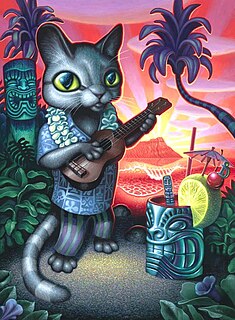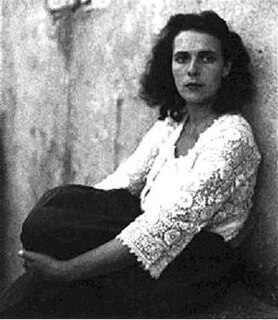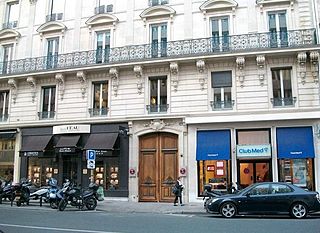Related Research Articles

Surrealism is a cultural movement that started in 1917, and is best known for its visual artworks and writings. Artists painted unnerving, illogical scenes, sometimes with photographic precision, creating strange creatures from everyday objects, and developing painting techniques that allowed the unconscious to express itself. Its aim was, according to Breton, to "resolve the previously contradictory conditions of dream and reality into an absolute reality, a super-reality", or surreality.

Joan Miró i Ferrà was a Spanish painter, sculptor, and ceramicist born in Barcelona. A museum dedicated to his work, the Fundació Joan Miró, was established in his native city of Barcelona in 1975, and another, the Fundació Pilar i Joan Miró, was established in his adoptive city of Palma de Mallorca in 1981.
Abstract expressionism is a post–World War II art movement in American painting, developed in New York in the 1940s. It was the first specifically American movement to achieve international influence and put New York City at the center of the western art world, a role formerly filled by Paris. Although the term "abstract expressionism" was first applied to American art in 1946 by the art critic Robert Coates, it had been first used in Germany in 1919 in the magazine Der Sturm, regarding German Expressionism. In the United States, Alfred Barr was the first to use this term in 1929 in relation to works by Wassily Kandinsky.

COBRA was a European avant-garde movement active from 1948 to 1951. The name was coined in 1948 by Christian Dotremont from the initials of the members' home cities: Copenhagen (Co), Brussels (Br), Amsterdam (A).
Conroy Maddox was an English surrealist painter, collagist, writer and lecturer; and a key figure in the Birmingham Surrealist movement.

Ithell Colquhoun was a British painter, occultist, poet and author. Stylistically her artwork was affiliated with surrealism. In the late 1930s, Colquhoun was part of the British Surrealist Group before being expelled because she refused to renounce her association with occult groups.

Lowbrow, or lowbrow art, describes an underground visual art movement that arose in the Los Angeles, California, area in the late 1970s. It is a populist art movement with its cultural roots in underground comix, punk music, tiki culture, graffiti, and hot-rod cultures of the street. It is also often known by the name pop surrealism. Lowbrow art often has a sense of humor – sometimes the humor is gleeful, sometimes impish, and sometimes it is a sarcastic comment.
Gerome Kamrowski was an American artist and pioneer in the Surrealist and Abstract Expressionist Movements in the United States.

Leonora Carrington OBE was a British-born Mexican artist, surrealist painter, and novelist. She lived most of her adult life in Mexico City and was one of the last surviving participants in the Surrealist movement of the 1930s. Carrington was also a founding member of the Women's Liberation Movement in Mexico during the 1970s.
Emmilia Federak Bridgwater, known as Emmy Bridgwater, was an English artist and poet associated with the Surrealist movement.

Lyrical abstraction is either of two related but distinct trends in Post-war Modernist painting:
The Birmingham Surrealists were an informal grouping of artists and intellectuals associated with the Surrealist movement in art, based in Birmingham, England from the 1930s to the 1950s.
Surrealist cinema is a modernist approach to film theory, criticism, and production with origins in Paris in the 1920s. The movement used shocking, irrational, or absurd imagery and Freudian dream symbolism to challenge the traditional function of art to represent reality. Related to Dada cinema, Surrealist cinema is characterized by juxtapositions, the rejection of dramatic psychology, and a frequent use of shocking imagery. Philippe Soupault and André Breton’s 1920 book collaboration Les Champs Magnétiques is often considered to be the first Surrealist work, but it was only once Breton had completed his Surrealist Manifesto in 1924 that ‘Surrealism drafted itself an official birth certificate.’

The history of Western painting represents a continuous, though disrupted, tradition from antiquity until the present time. Until the mid-19th century it was primarily concerned with representational and Classical modes of production, after which time more modern, abstract and conceptual forms gained favor.

20th-century Western painting begins with the heritage of late-19th-century painters Vincent van Gogh, Paul Cézanne, Paul Gauguin, Georges Seurat, Henri de Toulouse-Lautrec, and others who were essential for the development of modern art. At the beginning of the 20th century, Henri Matisse and several other young artists including the pre-cubist Georges Braque, André Derain, Raoul Dufy and Maurice de Vlaminck, revolutionized the Paris art world with "wild", multi-colored, expressive landscapes and figure paintings that the critics called Fauvism. Matisse's second version of The Dance signified a key point in his career and in the development of modern painting. It reflected Matisse's incipient fascination with primitive art: the intense warm color of the figures against the cool blue-green background and the rhythmical succession of the dancing nudes convey the feelings of emotional liberation and hedonism.

Women Surrealists are women artists, photographers, filmmakers and authors connected with the Surrealism movement, which began in the early 1920s.
Josip Seissel was a Croatian architect and urban planner, who under the pseudonym of Jo Klek was a constructivist artist, graphical designer and theatrical designer. A member of the influential avant-garde Zenit movement of the 1920s, he is considered to be a pioneer of surrealism and abstract art in Croatia.

The Exposition Internationale du Surréalisme was an exhibition by surrealist artists that took place from January 17 to February 24, 1938, in the generously equipped Galérie Beaux-Arts, run by Georges Wildenstein, at 140, Rue du Faubourg Saint-Honoré in Paris. It was organised by the French writer André Breton, the surrealists' brain and theorist, and Paul Éluard, the best known poet of the movement. The catalogue listed, along with the above, Marcel Duchamp as generator and arbitrator, Salvador Dalí and Max Ernst as technical advisers, Man Ray as head lighting technician and Wolfgang Paalen as responsible for the design the entrance and main hall with "water and foliage". The exhibition was staged in three sections, showing paintings and objects as well as unusually decorated rooms and mannequins which had been redesigned in various ways. With this holistic presentation of surrealist art work the movement wrote exhibition history.

Judit Reigl is a Hungarian painter living in France.

Self-Portrait is a painting executed by the English artist Leonora Carrington and is currently in the collection of the Metropolitan Museum of Art. She began the painting in London in 1937 and completed it in Paris in 1938. It is one of her most recognized works and has been called her "first truly Surrealist work."
References
- 1 2 Hoffman, Katherine (1984). An enduring spirit: the art of Georgia O'Keeffe . Scarecrow Press. p. 74. ISBN 978-0-8108-1672-5 . Retrieved 6 October 2011.
- ↑ "Surrealism". Britannica Online. Retrieved 6 October 2011.
- ↑ A Cobra portfolio: a selection of abstract artists in Europe post World War II : April 21-June 14, 1981, Emily Lowe Gallery, Hofstra University, Hempstead, N.Y. 11550. The Gallery. 1981. Retrieved 6 October 2011.
- ↑ Arts magazine. Art Digest Inc. 1 January 1975. p. 93. Retrieved 6 October 2011.
| This art movement-related article is a stub. You can help Wikipedia by expanding it. |